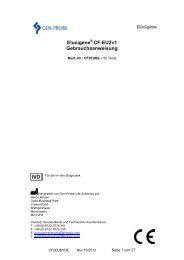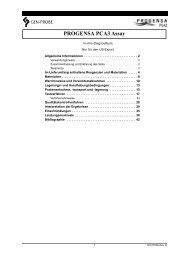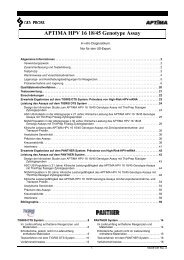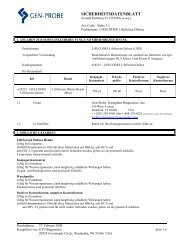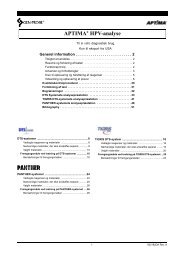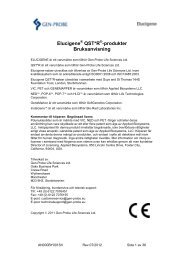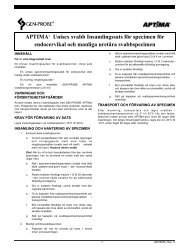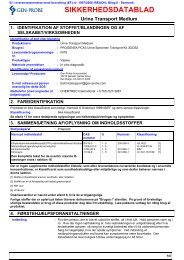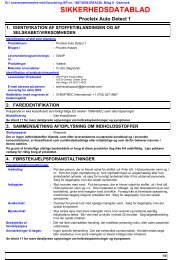APTIMA Trichomonas vaginalis Assay - Gen-Probe, Inc.
APTIMA Trichomonas vaginalis Assay - Gen-Probe, Inc.
APTIMA Trichomonas vaginalis Assay - Gen-Probe, Inc.
Create successful ePaper yourself
Turn your PDF publications into a flip-book with our unique Google optimized e-Paper software.
<strong>Gen</strong>eral Information<br />
Intended Use<br />
<strong>Gen</strong>eral Information<br />
The <strong>APTIMA</strong> <strong>Trichomonas</strong> <strong>vaginalis</strong> <strong>Assay</strong> is an in vitro qualitative nucleic acid amplification test<br />
(NAAT) for the detection of ribosomal RNA (rRNA) from <strong>Trichomonas</strong> <strong>vaginalis</strong> to aid in the<br />
diagnosis of trichomoniasis using the TIGRIS DTS System.<br />
The assay may be used to test the following specimens from symptomatic or asymptomatic<br />
women: clinician-collected endocervical swabs, clinician-collected vaginal swabs, female urine<br />
specimens, and specimens collected in PreservCyt Solution.<br />
Summary and Explanation of the Test<br />
<strong>Trichomonas</strong> <strong>vaginalis</strong> (TV) is the most common curable sexually transmitted disease (STD)<br />
agent in the U.S., with an estimated 7.4 million new cases occurring annually (1, 2).<br />
Infections in women cause vaginitis, urethritis, and cervicitis. Discharge and small hemorrhagic<br />
lesions may be present in the genitourinary tract. Complications can include premature labor,<br />
low-birth-weight offspring, premature rupture of membranes, and post-abortion or posthysterectomy<br />
infection. An association with pelvic inflammatory disease, tubal infertility, and<br />
cervical cancer with previous episodes of trichomoniasis has been reported. Symptomatic<br />
women with trichomoniasis usually complain of vaginal discharge, vulvovaginal soreness, and/or<br />
irritation. Dysuria is also common. However, it has been estimated that 10% to 50% of<br />
T. <strong>vaginalis</strong> infections in women are asymptomatic, and in men the proportion may even be<br />
higher (3, 4, 5).<br />
Detection of T. <strong>vaginalis</strong> with traditional culture methods is technically challenging and requires<br />
up to 7 days. Immediate inoculation into the media is preferred, and proper incubation conditions<br />
are required in addition to frequent microscopic examinations of the media to successfully culture<br />
the protozoa. The sensitivity of culture has been estimated to range from 38% to 82% when<br />
compared to molecular methods due to problems visualizing low numbers of the organisms or<br />
the motility of the protozoa (6, 7).<br />
T. <strong>vaginalis</strong> may also be detected using “wet-mount” preparation by mixing vaginal secretions<br />
with saline on a slide and examining the slide under a microscope. However, the wet-mount<br />
method is only 35% to 80% sensitive compared with culture (7). The sensitivity of the wet-mount<br />
method is highly dependent on the experience of the microscopist as well as the time of<br />
specimen transport to the laboratory.<br />
The <strong>APTIMA</strong> <strong>Trichomonas</strong> <strong>vaginalis</strong> <strong>Assay</strong> is a nucleic acid test that utilizes Target Capture,<br />
Transcription-Mediated Amplification (TMA), and Hybridization Protection <strong>Assay</strong> (HPA)<br />
technologies.<br />
Principles of the Procedure<br />
The <strong>APTIMA</strong> <strong>Trichomonas</strong> <strong>vaginalis</strong> <strong>Assay</strong> combines the technologies of target capture,<br />
transcription-mediated amplification (TMA), and hybridization protection assay (HPA).<br />
Specimens are collected and transferred into their respective specimen transport tubes. The<br />
transport solution in these tubes releases the rRNA target and protects it from degradation<br />
during storage. When the <strong>APTIMA</strong> <strong>Trichomonas</strong> <strong>vaginalis</strong> <strong>Assay</strong> is performed in the laboratory,<br />
the target rRNA molecule is isolated from the specimens by the use of a specific capture<br />
<strong>APTIMA</strong> <strong>Trichomonas</strong> <strong>vaginalis</strong> <strong>Assay</strong> 2 502246 Rev. B



